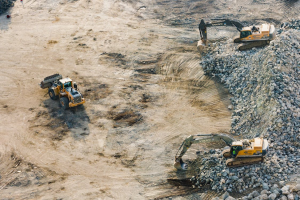
According to Federal Emergency Management Agency, landslides occur in 50 out of 52 states in the U.S., causing 18-50 deaths annually and affecting infrastructure, property, and the environment. If your residential area is prone to landslides, you’ve come to the right place. Our expert engineers shared valuable insight into landslide damages and repairs and how to deal with the aftermath.
Here’s what you need to know:
Try Soil Nailing
This is another cost-effective way to reinforce a ground zone. You can make these zones using a crane on steep slopes like bluffs. These are great for permanent or temporary excavation support to make a gravity retaining wall. Using tension-resisting, grouted steel nails to reinforce and pack the soil.
In soil nailing, the top soil layers are excavated, and tension-resisting steel bars are added to horizontal holes drilled into the surface and grouted into place with a drainage system before filling the ground. After that, you can attach bearing platers to soil nail heads based on the wall depth.
Add A Concrete Wall To Prevent Landslide Damage
Concrete walls must be proportioned well to prevent landslides and resulting damage. The base slab’s depth should be at least two feet from the bottom and the first line if your residential area experiences frost and snow in winter. The base slab also accounts for 50 to 70 percent of the wall’s total height, including the top of the stem to the base’s bottom.
After building forms and footings, you must reinforce the wall with rebar. If the wall is higher than four feet, pour each foot separately. Once the poured concrete has properly cured, create contraction joints every 4 to 6 feet. After the structure has cured, remove the forms and install a drainage system and waterproofing. Also, to prevent future landslides, install a footing key to reduce sliding resistance and mitigate landslide damage.
Add A Retaining Wall To Mitigate Landslides
You can add a block, stone, or brick retaining wall, but it has to be on level ground. You must avoid backfilling with clay soil because when it gets heavy with water, it’ll increase the pressure against the wall. Therefore, you’ll need some earthwork and excavation deep enough to lay the foundation for the retaining wall. We also recommend installing a ½ to ¾ inch crushed stone base to help the soil drain and stay in place.
You must compact the soil because excavation will loosen it. Therefore, tamp it down tight to avoid settling, which may cause the wall to bend afterward and increase the risks of landslide damage.
Call Us Today For Landslide Repair Services
Are you looking for landslide repair experts in California? Look no further than Mountain Movers Engineering Co. We offer slope restoration, retaining wall, screen wall repairs and installation, and more.
Reach out to us today for more information on our retaining wall construction and repair services.









No comment yet, add your voice below!